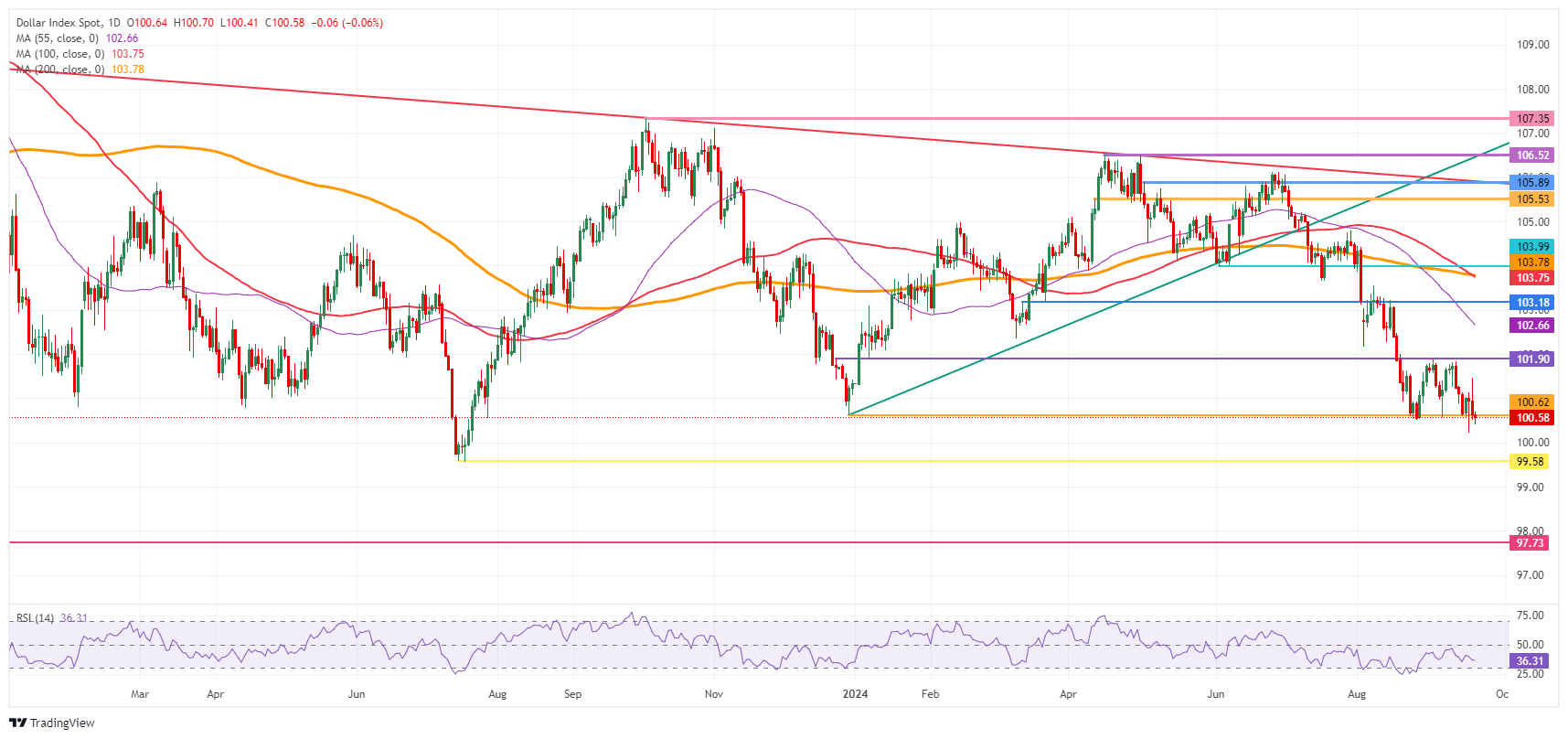- The US Dollar consolidates on Friday after weakening further on Thursday..
- Traders have repriced the US Dollar amidst the Bank of Japan and Bank of England’s decisions to keep rates on hold.
- The US Dollar Index falls outside its tight bandwidth, a sign that could dive lower next week.
The US Dollar (USD) trades broadly steady on Friday after Thursday’s sharp decline, when traders revalued the Greenback after the US Federal Reserve (Fed) joined the European Central Bank (ECB) and several others by starting its interest-rate cutting cycle. Quite a different picture comes from the Bank of England (BoE) and the Bank of Japan (BoJ), which decided to keep interest rates steady, causing the US Dollar to struggle against the British Pound (GBP) and the Japanese Yen (JPY).
On the economic data front, the US economic calendar is quite empty, which is ideal for traders to let the dust settle after a volatile week. Next week, a lot of US data is set to be released. The main elements include the final US Gross Domestic Product (GDP) data for Q2 and the Personal Consumption Expenditures (PCE) Price Index, the Fed’s preferred inflation gauge.
Daily digest market movers: A very quiet Friday
- The Bank of Japan (BoJ) has kept its interest rate stable at 0.25%. BoJ Governor Kazuo Ueda mentioned that inflation came in a little softer than anticipated, that the BoJ is keeping a close eye on the economic data, and that it is ready to hike at any moment when needed.
- Federal Reserve Bank of Philadelphia President Patrick Harker delivers a speech titled "The Federal Reserve: it's more than just interest rates" at the Tulane University Freeman School of Business Lecture in New Orleans at around 18:00 GMT.
- Equity markets are facing some profit taking after the steep rallies that took place in the aftermath of the Fed rate decision. Both European equities and US Futures are in red numbers. Still, losses are rather contained, by no more than 0.5% on average.
- The CME Fedwatch Tool shows a 59.3% chance of a 25-basis-point rate cut at the next Fed meeting on November 7. The remaining 40.7% is pricing in another 50-basis-point rate cut.
- The US 10-year benchmark rate trades at 3.71%, rather in the middle of this week’s range between 3.60% and 3.76%.
US Dollar Index Technical Analysis: Think ahead of November
The US Dollar Index (DXY) is in a precarious situation. A weekly close below that line in the sand of 100.62 could point to further weakness ahead. A further depreciation could take place next week if US data eases further, opening the door to another big rate cut in November.
The upper level of the recent range remains 101.90, with the DXY still possible to recover above 100.62 first. Further up, the index could go to 103.18, with the 55-day Simple Moving Average (SMA) at 102.66 on the way. The next tranche up is very misty, with the 200-day SMA and the 100-day SMA at 103.76, just ahead of the big 104.00 round level.
On the downside, 100.62 (the low from December 28, 2023) is being broken again and could point to more weakness ahead. Should that take place next week, the low from July 14, 2023, at 99.58, will be the next level to look out for. If that level gives way, early levels from 2023 are coming in near 97.73.
US Dollar Index: Daily Chart
Risk sentiment FAQs
In the world of financial jargon the two widely used terms “risk-on” and “risk off'' refer to the level of risk that investors are willing to stomach during the period referenced. In a “risk-on” market, investors are optimistic about the future and more willing to buy risky assets. In a “risk-off” market investors start to ‘play it safe’ because they are worried about the future, and therefore buy less risky assets that are more certain of bringing a return, even if it is relatively modest.
Typically, during periods of “risk-on”, stock markets will rise, most commodities – except Gold – will also gain in value, since they benefit from a positive growth outlook. The currencies of nations that are heavy commodity exporters strengthen because of increased demand, and Cryptocurrencies rise. In a “risk-off” market, Bonds go up – especially major government Bonds – Gold shines, and safe-haven currencies such as the Japanese Yen, Swiss Franc and US Dollar all benefit.
The Australian Dollar (AUD), the Canadian Dollar (CAD), the New Zealand Dollar (NZD) and minor FX like the Ruble (RUB) and the South African Rand (ZAR), all tend to rise in markets that are “risk-on”. This is because the economies of these currencies are heavily reliant on commodity exports for growth, and commodities tend to rise in price during risk-on periods. This is because investors foresee greater demand for raw materials in the future due to heightened economic activity.
The major currencies that tend to rise during periods of “risk-off” are the US Dollar (USD), the Japanese Yen (JPY) and the Swiss Franc (CHF). The US Dollar, because it is the world’s reserve currency, and because in times of crisis investors buy US government debt, which is seen as safe because the largest economy in the world is unlikely to default. The Yen, from increased demand for Japanese government bonds, because a high proportion are held by domestic investors who are unlikely to dump them – even in a crisis. The Swiss Franc, because strict Swiss banking laws offer investors enhanced capital protection.
Tags: Featured,newsletter

























